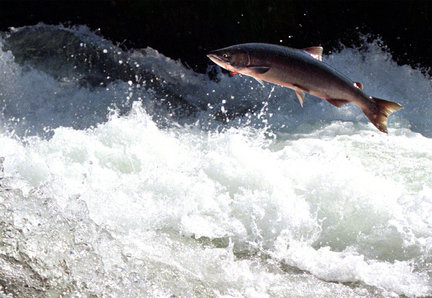forum
library
tutorial
contact

Increasing Sockeye Returns are Great News
by John McKernWalla Walla Union-Bulletin, June 20, 2012
|
the film forum library tutorial contact |

|
Increasing Sockeye Returns are Great Newsby John McKernWalla Walla Union-Bulletin, June 20, 2012 |
 The U-B recently ran articles about the collapse of Alaska Chinook salmon runs and
the record run of Columbia River sockeye salmon.
The U-B recently ran articles about the collapse of Alaska Chinook salmon runs and
the record run of Columbia River sockeye salmon.
Chinook runs from California to Alaska are influenced by the Pacific decadal oscillation, ocean temperature changes that occur on roughly a 10-year cycle. Whether returning runs are good or bad depends on the temperature and related food availability are where juvenile salmon rear in the ocean.
Where cool upwelling is occurring and food is plentiful, salmon rearing there return in larger numbers and at larger sizes. Where conditions are poor, runs that rear there do poorly. Runs from specific coastal areas go to different ocean areas to rear.
Regional fisheries agencies have decided the ocean is a big black box where all salmon rear together and how many adults return is controlled by the survival of juvenile salmon through the hydropower system. Their belief is fueled by $900 million per year of management and research funding from the Bonneville Power Administration tied to the hydropower system.
Juvenile sockeye require a lake for freshwater rearing. The record run is predominantly wild fish returning to the Okanagan and Osoyoos Lakes in the mid-Columbia. Lest you think that the Snake River runs are endangered because of dams, the mid-Columbia sockeye migrate through five public utility district dams and four U.S. Corps of Engineers dams.
Like the Corps dams, the PUD dams were built with fish ladders for adult salmon, and retrofitted with effective facilities for juvenile salmon passage. Adult and juvenile salmon survival is no higher through the PUD dams than through the Corps dams, so forget about breaching the Snake River dams to save the sockeye.
Snake River sockeye runs were lost to an Oregon Fish Commission dam below Wallowa Lake by 1902, a dam below Payette Lake in 1905 and Sunbeam Dam that blocked salmon access into the Salmon River Stanley Basin from 1917 to 1935. Snake River ocean-going sockeye were probably extinct then.
In the 1950s, Idaho Department of Fish and Game poisoned the kokanee (landlocked sockeye) in the Stanley Basin lakes to manage them for cutthroat trout. They later relented and restocked the lakes with sockeye from Canada. National Marine Fisheries Service studies in the 1990s were unsure where the sockeye were from but they were declared endangered in 1992.
Nonetheless, record returns of Columbia River sockeye, and increasing returns of Snake River sockeye are great news.
Bert:
Misinformation continues - Redfish and Alturas were not poisoned - an astute fisheries biologist would know that sockeye were able to rebound via anadromous kokanee. The only lake stocked with Canadian sockeye was Stanley - none returned. Listing had nothing to do with Canadian sockeye.
learn more on topics covered in the film
see the video
read the script
learn the songs
discussion forum
